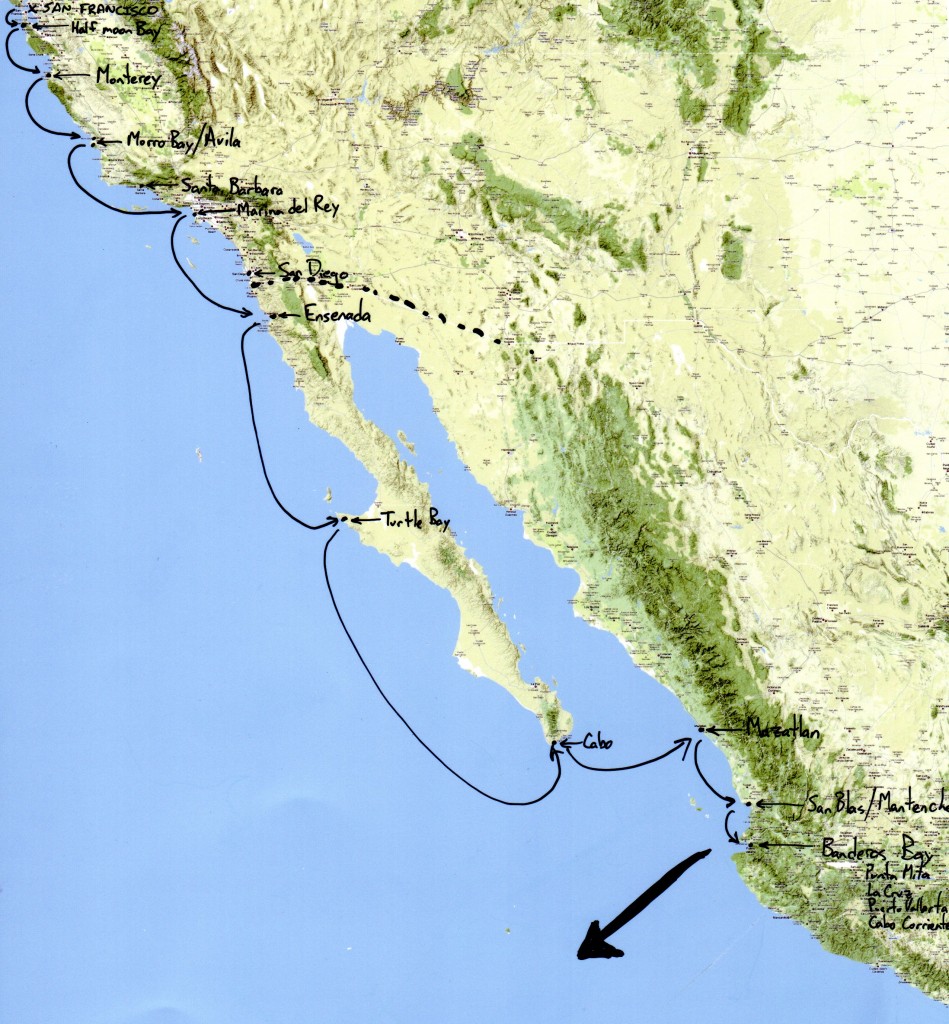Nov 09
“Where are you going?”
Excellent question! We’re leaving in January (worst weather off the coast of California is in January) and heading south down the coast to Mexico. Then we will cross the pacific. Maybe in March or April? At this point we’re open to suggestions and easily influenced.
I have illustrated our basic plan on the diagram below, which admittedly is little better than a napkin sketch.

So that’s my cheat sheet, to help me keep it all straight in my head. “How do you know where to stop?” is another excellent question. I chose the stopping points on the map above largely from information gleaned from Louis and Laura, a fantastic couple who we are lucky to count among our friends. I used to race on the bay with Louis and Laura until they sailed their boat Cirque down the coast; they have been cruising all over the coast of Mexico since then (i.e. good people to ask for advice).
On their recommendation, Karen and I visited Waypoint in Oakland, a store which specializes in charts and navigation-related boating information (the owners also have a winery in the warehouse next to the store–very cool). We purchased two chart books and a cruising guide, and each night since then we have been spending a little time planning.
Maps of the sea are called “charts”. Together with a compass, the chart is the foundation for navigation: it is used to figure out where you are, where you’re going, and how to get there. Old-school charts (still readily available) are huge pieces of paper that you roll up and stuff in tubes to store, and then can never use because you can never flatten the damn things out again. A “chartbook” contains the same charts cut up into conveniently sized 16″ x 22″ sheets and spiral bound.
The two chartbooks we purchased at Waypoint are titled “Southern California” and “Mexico to Panama“. While sailing, one of these chartbooks will be open to the page for our location and we’ll plot our progress on it.
The charts are necessary for figuring out the route from port to port, but they don’t give information about where to go once you actually arrive. Some of the things we need to know about each port are
1) are there any obstacles and dangers while trying to enter the harbor that aren’t marked on the charts?
2) can we anchor? if so, where? if we can’t anchor, what marina do we go to and how much does it cost per night for a slip?
3) where is the dinghy dock or beach (the convenient spot to tie up the dinghy while going about your business on land) and how much does it cost?
4) where is the fuel dock, if we need more diesel?
5) where is the harbormaster’s office, so we can take care of any necessary paperwork?
The “cruising guide” is the source for this information. The cruising guide consists of mostly text, with rudimentary charts of each harbor (sometimes hand-drawn). I chose the “Mexico Boating Guide” by Rains; “Charley’s Charts” is another popular one.
And since I love maps and navigation, for extra credit I’m printing out 11″x17″ aerial photos from google maps of some of the anchorages in Mexico for which we have no detailed charts. It’s amazing how much information you can glean from the aerial photo–you can see where the sailboats are anchored, and you can see where it’s shallow because the water changes color. Also, it feels much more real and exciting when you can see other sailboats anchored out in the same spot where we will be.
Armed with these resources, we have been working out way down the coast, examining each port on the list we gleaned from Louis and Laura, looking at the charts and locating the anchorage, discussing the merits of whether to stop or skip each possible harbor down the coast. Most of the harbors get relegated to the “backup list”, to be used in an emergency, or if we get too exhausted and need to duck in for a rest. Some harbors–like Marina Del Rey and Ensenada on the map above–get the special nod as ideal places to resupply food or diesel. Others are unavoidable: Turtle Bay for example is pretty much the only protected harbor between Ensenada and Cabo San Lucas.
So we have the charts and the cruising guide and we know where we’re going to start and where we might visit, and that’s enough for now!
November 11th, 2009 at 6:00 pm
You guys are going to be passing right by many of the world’s best big waves: Maverick’s (Half Moon Bay), Ghost Tree (Monterey), and Todos Santos (12 miles from Ensenada). Check out this video: http://www.youtube.com/watch?v=IWoKkaWieE4
November 20th, 2009 at 6:35 pm
Watch out for water in the fuel in Turtle bay.
Magdelina Bay is a good (remote) anchorage between Turtle & Cabo, especially if it’s whaling season.
Cabo is good for some things, but if your at anchor it sucks. Party barges every night thru the anchorage, and very rolly and exposed. At the docks is much better but expensive. Check out La Paz just around the corner as an alternative.
Glad to give more feedback if you’d like.
January 28th, 2010 at 6:06 pm
This boat is at Mag Bay now (or just left) in case you want to see some photos to feed the dream: http://maiaaboard.blogspot.com/2010/01/where-we-are-mag-bay.html